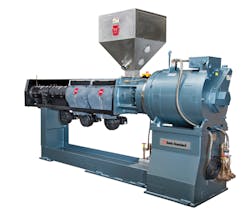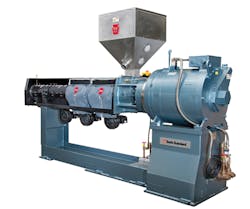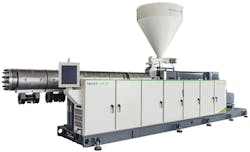NPE: Machinery firms out in force with innovations
Finding extrusion technology innovations at NPE was easy. They were all around no matter which hall you were in. The only problem was running out of time before seeing all you wanted to see. Innovations ranged from completely new machines and processing lines to components to software to, well, you name it.
Although the innovations span every component of every type of extrusion system or machine, they also have something in common—their goal. Suppliers stay up late designing and engineering technology to give processors and end user real benefits and marketplace advantages. They describe all the new and upgraded technologies first in terms of their benefits, and then come the engineering details.
Let's take a look at some of the great extrusion offerings at the biggest NPE ever.
Hydroscopic materials without a dryer
The booth of sheet extrusion machinery supplier Processing Technologies International LLC, Aurora, Ill., contained two examples, one new and one emerging, of technology designed to meet evolving end-market trends while simultaneously advantaging the processors that use it.
PTi's NPE show line, which featured an 85mm/52D high-vacuum twin-screw extruder (HVTSE) and GCH661824 horizontal roll stand, can make 57-inch-wide PET and polylactic acid (PLA) sheet as thin as 6 mils and PP sheet as thin as 11 mils. Operating at 2,300 pounds per hour it will produce 18 million pounds of thin PET sheet in a year. Based on the units sold since the line's launch this yields a theoretical annual capacity of 390 million pounds of North American PET sheet production. This is definitely an emerging technology.
Matthew Banach, PTi's vice president of sales and marketing, told PMM that PTi thought energy savings and process simplification would be the selling points of this line, but resin versatility proved to be the big draw. Other sizes of this line can process PET at rates up to 5,500 pounds per hour and every model can convert resins such as post-consumer and industrial PET/PLA, PP, HDPE, HIPS and many more.
The energy efficiency comes from the twin-screw extruder eliminating raw material drying and crystallizing, and it is not trivial. HVTSE technology reduces energy consumption by about 80-85 kilowatt-hours per 1,000 pounds of PET, versus conventional processing.
Banach noted that the show line included PTi's new G-Series configurable roll stand, launched at NPE and covered in PMM's April issue. Also designed to provide greater flexibility, it significantly reduces downtime for downstream configuration changes such as inline thermoforming to roll stock production.
Banach said the G-Series stand rests on a leveling base and linear bearings similar to milling machines, rather than on rails set into the floor and grouted, which removes variability from crumbling grout. This is critical when making thin sheet with tolerances that can be half a thousandth of an inch. The linear bearing design is standard and patented, as are a ratcheting vertical nip height adjustment, a mechanical roll lock-out and transfer roll coating for top and/or bottom application.
Multiple upgrades to blown film
auto-profile
Addex Inc., Stoughton, Mass., which specializes in high-performance auto-profile-related technology designed to improve the performance of any supplier's blown film line, came to NPE with a long list of hardware and software upgrades based on the latest electronic miniaturization and distributed controls.
For new installations, performance is boosted by easy integration of its automatic air ring, which offers what Addex terms an industry-leading number of control zones, with existing auto-profile components. For existing Addex systems, there are electronics upgrades to significantly improve connections and notably reduce maintenance. The goal is enabling processors to increase their yields and save raw material costs by reducing thickness variations.
The new auto-profile upgrades include a Smart-Fusion distributed control with Ethernet point-to-point connectivity and AC power that provides the sole interconnection between major modules and a second Smart-Fusion control with different programming that connects locally to each main function of the gauge-control system. Addex has a new user interface based on a Windows 7 Pro-based touchscreen PC. A separate Ethernet connection supports mining of plant data and centralized connection with other modules.
A Live Ring module replaces the previous junction box and its electronics with pre-made cables from Turck Inc., Minneapolis, providing plug-and-play connection to the Live Ring module. The shuttle junction box and its electronics make way for the shuttle module, also plug-and-play with Turck cables. Replacing 485 discrete hand-wired modules, the new Mapper module located near the reversing nip unit produces a fully mapped thickness profile using input from the nip roll speed and oscillating haul-off position.
New technology for an emerging
biomaterials market
At NPE Macro Engineering & Technology Inc., Mississauga, Ontario, told the industry about its completely new extrusion line designed to produce PLA foam sheet. The market for compostable foam thermoformed meat trays, clamshells, plates, cups and more has expanded, partly due to the recent ban of EPS foam in many U.S. cities and various locations around the globe.
Speaking in Macro's booth, Richard Lee, R&D project manager, told PMM that PLA is one of the most challenging materials to foam. Compared to PS, PLA has a very narrow foaming window. It is a semi-crystalline material with a relatively low molecular weight resulting from condensation polymerization. Achieving high melt strength requires a chain-extending reaction and the foaming equipment must provide uniform melt temperature distribution. Other critical control factors include: pressure and pressure drop rate; the material recipe; equipment heating and cooling; and screw and die design.
Macro's answer to that challenge is a purpose-designed, turnkey system that it says is the first commercial PLA foam sheet line that comes complete with the material recipe, processing conditions, process training, and without any royalty. The new line is a tandem, two-extruder, multi-layer system, too long to bring to the show. The primary extruder is 102mm, the secondary is 114mm and maximum output is about 660 pounds per hour. Since extruded sheet density is about 0.07 grams per cubic centimeter, that is significant production. To handle the melt strength issue, Macro designed a sophisticated water-cooled system for high-efficiency barrel temperature control.
This line also marks the first commercialization of heat-resistant PLA foam sheet technology, which optimizes the sheet for thermoforming as well as for end-use with hot contents. Conventional PLA foam softens around 131 degrees Fahrenheit. Macro's multilayer technology, which can include a solid skin, combined with a new PLA grade from NatureWorks LLC, Minnetonka, Minn., enables a thermoformed bowl of heat-resistant PLA foam to hold boiling water without distorting.
New market-specific
pipe & profile extruders
Pipe, profile and sheet extrusion systems supplier Battenfeld-Cincinnati USA, McPherson, Kan., was showing two new machines, one in its twinEX twin-screw series and the other in its solEX single-screw series. The company says the new twinEX 148-28 is the industry's highest output, large-diameter machine and is engineered to meet growing demand for large-diameter PVC pipe and high-output profile extrusion in the North American market. It is also capable of making foamed PVC sheet. Its main motor is in the back for easy maintenance. It can process both virgin and regrind PVC at rates up to 4,400 pounds per hour.
The first solEX 150 single-screw extruder moves the top of that series from 120mm to 150mm. With low melt temperatures and homogeneous polyolefin melt, this extruder is aimed at a growing demand for large-diameter, heavy-wall polyolefin pipe and will produce up to 6,000 pounds per hour of HDPE pipe. Continuous speed control and a bimetallic air-cooled barrel with a high-conveying-capacity feed section, matched with an engineered barrier screw design, make the solEX 150 energy efficient.
Turning to the company's thermoforming sheet systems, Grant Flaherty, Battenfeld-Cincinnati's president, pointed first to the Multi-Touch roll stack making its NPE debut. Demand for increased output is going beyond the cooling capacity of traditional roll stacks. Using wider lines or bigger rolls can lead to lower quality, consume floor space and make equipment more difficult to handle. Solution: The Multi-Touch creates uniform cooling on the top and bottom of the sheet. The higher cooling efficiency improves transparency of polymers such as PE and PP and can dramatically reduce tolerances. The Multi-Touch 1400 was developed with the U.S. market in mind.
Direct-drive and high-speed
extrusion and 3-D printing
Davis-Standard LLC, Pawcatuck, Conn., had a display that reflected the broad scope of its product lines and the markets it serves, but one emerging market on display likely surprised some attendees: 3-D printing/additive manufacturing. The technology was visible along one side of the Davis-Standard booth where an extrusion line was quietly making ABS filament. The filament was then fed into a 3-D printer to demonstrate how this process can be used as a rapid, yet lower cost way to make prototypes. (See related 3-D printing story, page 9).
A principal focus of Davis-Standard's display was on direct-drive extrusion technology, which uses a permanent magnet synchronous motor that drives the screw directly, eliminating the need for a mechanical gear reducer to multiply torque. Davis-Standard showed the results of recent tests that demonstrated direct drive's advantages over both AC and DC extruders in energy consumption, sound level and output consistency.
John Christiano, Davis-Standard's VP of technology, said the tests show that noise levels were reduced as much as 70 percent with direct-drive technology. He said that the substantial energy savings of the machine itself could be further increased by as much as 15 percent by adding an optimized screw design. Other benefits include a notably smaller footprint than an AC or DC machine with comparable output and the ability to process a greater variety of resins with consistent quality. Davis-Standard's direct-drive technology is available in extruder sizes up to 114mm.
The company also was showing its XP Express packaging sheet roll stand system, created for versatility. Intended primarily for packaging processes using PP, amorphous PET and PS in the fast-growing beverage and prepared foods markets, the roll stand also works for EVA, TPA and vinyl acetate copolymers in solar energy applications and barrier sheet of 100 layers or more. Davis-Standard engineered it to support direct extrusion, in-line thermoforming or making roll stock for later forming. Ready for multilayer, single-layer and barrier sheet and a variety of materials, this roll stack is a real solution for sheet processors supplying increasingly diverse end-users.
Make changeovers faster,
keep clean room clean
NPE marked the first combined showing of Graham Engineering Corp.'s three brands—extrusion stalwarts American Kuhne, Ashaway, R.I., Welex, York, Pa., and extrusion blow molding specialist Graham Engineering, also of York. The innovations Welex and American Kuhne displayed concentrated on cutting changeover downtime, saving energy and increasing automation.
Changeovers take time, and doing them in a clean room is tougher yet. American Kuhne has a solution: Its Modular Quick-Change extrusion system takes the dirty work out of the clean room by hot-swapping the barrel, screw and die head. The extruder's modular design allows removal of the barrel and substituting a pre-heated barrel with pre-mounted tooling. How it can reduce changeover time as much as 80 percent was demonstrated at the show.
American Kuhne also presented SMED Quick-Change design options aimed at turning downtime into production. Shown on an American Kuhne E3 extruder during the show, these options include: rapid screw change via quick-mount pusher; fast material change via rotary hopper design; and instant tooling change via dual-hinge design.
Nearby, Welex was showing an example of Graham group synergy. Its XSL Navigator control system, adapted from the XBM Navigator control system on Graham Engineering blow molding systems, brings intuitive navigation to Welex lines. An operator can set up quickly and work easily with the system. Built on an industrial PC, the system lets a processor integrate data from a machine or line into an ERP system using client-server architecture.
Welex was also showing how its Welex Converge CTS dryer-less conical twin-screw technology for processors running PLA and PET offers energy savings and superior intrinsic viscosity retention versus parallel twin-screw systems thanks to its reduced dwell time. In its trial of a Welex Converge CTS system, NatureWorks measured virtually no loss of molecular weight through eight passes of its PLA resin.
Very thin PET cast film, ultra-flat film for converting
Reifenhäuser Cast Sheet Coating, Troisdorf, Germany, came to Orlando for the U.S. debut of its Mirex-MT polishing stack, which, among other benefits, permits production of very thin film. The company says PET film of 120 micrometers and even thinner can now be made with excellent tolerances for double-polished, high-quality products. This new thinness lets producers of blister and display packaging gain considerable cost advantages.
The new polishing stack features a mechatronic roll set-on device based on technology in the latest high-precision machine tools. Besides enabling very thin film, the Mirex-MT-V polishing stack realizes about an 80 percent reduction in both product changeover times and rejects. The nip is adjusted digitally with high precision, says the company. The next design in the series, the Mirex-MT-HS, is being launched now, making this technology available to makers of PS and PP film. Reifenhäuser says the lack of hydraulics in the Mirex polishing stacks means they can be installed in clean rooms and meet the criteria for food packaging.
Reifenhäuser Blown Film, Worms, Germany, presented a series of innovative technologies. Ultra Cool is called the operator-friendly, high-capacity cooling system for the highest possible output rate. Ultra Fusion joins compounding and blown film extrusion in a single process. Ultra Cool FFS is a production system specifically for heavy-duty shipping bags with an output rate of 1,000 pounds per hour using a 6.9-inch die.
Ultra Flat from Reifenhäuser Blown Film is a system meant to allow film to be printed and converted at high speeds because it lies so flat. The inline flattening system, which is installed after the primary nip roll but before the air-turning bar, improves film flatness notably. This allows higher-speed converting and reduced scrap rates. Because the system also vastly improves roll quality the company is increasing the sale of film rolls.
Rob Neilley, senior correspondent
Contact:
Addex Inc., 781-344-5800, www.addexinc.comAmerican Kuhne, 401-326-6200, www.americankuhne.comBattenfeld-Cincinnati USA, 620-241-6843, www.battenfeld-cincinnati.comDavis-Standard LLC, 860-599-1010, www.davis-standard.comGraham Engineering Corp., 717-848-3755, www.grahamengineering.comMacro Engineering & Technology Inc., 905-507-9000, www.macroeng.comProcessing Technologies International LLC, 630-585-5800, www.ptiextruders.comReifenhäuser Blown Film, 49-6241-902-0, www.reifenhauser-bf.comReifenhäuser Cast Sheet Coating, 49-2241-481-0, www.reifenhauser-csc.comWelex, 215-542-8000, www.welex.com


